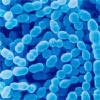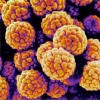|
 INDOOR MOLDS are simple, microscopic organisms that exist naturally in the environment. They grow in damp, poorly ventilated areas. Although there is still a great deal of debate on the issue, in some people may exhibit adverse reactions when exposed to mold. INDOOR MOLDS are simple, microscopic organisms that exist naturally in the environment. They grow in damp, poorly ventilated areas. Although there is still a great deal of debate on the issue, in some people may exhibit adverse reactions when exposed to mold.
|
|
NAME
|
SOURCE
|
MOISTURE NEEDED FOR GROWTH
|
Alternaria |
Moist windowsills, walls, cooling coils, filters, paint dust, carpets |
Low to
Moderate |
Aspergillus |
The spores are frequently present indoors, even in relatively clean environments in wallpaper, glue, house dust, cloth, leather, textiles, potting soil, fiberglass insulation, ceiling tiles, decaying plants |
Low to
Moderate |
Cladosporium |
Moist windowsills, wood, old window frames, carpet, walls, building Materials, metal surfaces, dust, soil, textiles, leather |
Low to
Moderate |
Fusarium |
Water-damaged carpet, humidifiers |
High |
Penicillium
|
They are found in soil and decaying vegetation. Also in damp wallpaper behind paint, painted surfaces, air conditioners, ducts, filters, dust, wine cellars, leather, fabric, paper, on skin and house dust. |
Low to
Moderate |
Stachlybotrys |
A greenish-black fungus that grows in high-cellulose material, such as soil, decaying plants, wallboard, carpet, wall paper, fiber-board, and ceiling tiles where the relative humidity is above 55%. It does not grow on plastic, vinyl, concrete products, or ceramic tiles. |
High |
Aureobasidium |
Damp window frames, drip pans, house siding, painted surfaces, Building materials, filters |
High |
ASSISTANCE: Associations needing legal assistance can contact us. To stay current with issues affecting community associations, subscribe to the Davis-Stirling Newsletter.